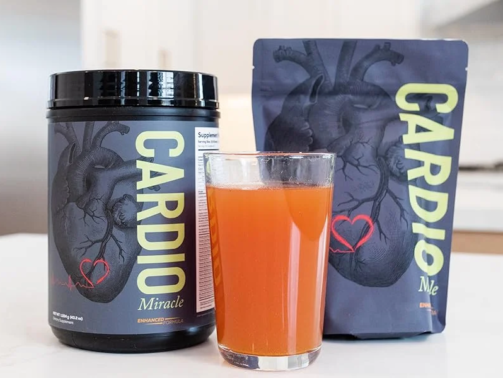Cardio
Maximizing Cardio Recovery: How Active Recovery Can Supercharge Your Fitness
Whether you're a beginner in fitness or an experienced athlete, recovery is as vital as the workout ...
Does Cardio Kill Gains? The Truth Behind the Myth By Dr.Mike
The question “does cardio kill gains?” has stirred debate for years among lifters, bodybuilders, an ...
Cardio Miracle Review: Boost Heart Health and Energy with This Nitric Oxide Supplement
Cardio Miracle is a comprehensive nitric oxide supplement designed to support cardiovascular health ...
Cardio Subcategory Overview: Types, Benefits, Techniques, and Best Practices
Cardio, short for cardiovascular exercise, is a fundamental component of any well-rounded fitness regimen. At ReviveYourFitness.com, we emphasize the importance of cardio for improving heart health, enhancing endurance, supporting weight management, and boosting overall well-being. Whether you’re a beginner just starting out or a seasoned athlete looking to fine-tune your routine, understanding the various types of cardio training can help you achieve your health and fitness goals effectively.
This comprehensive guide covers everything you need to know about cardio, including popular workouts, training methods, benefits, heart rate zones, and how to combine cardio with strength training. Popular topics include Zone 2 cardio, fasted cardio, LISS cardio, HIIT cardio, and more.
What Is Cardio?
Cardio is any exercise that elevates your heart rate and maintains it for an extended period. This form of aerobic activity strengthens your heart, lungs, and circulatory system, enabling your body to use oxygen more efficiently. It also helps burn calories, making it a staple in most fitness programs focused on weight loss or endurance.
Common Examples of Cardio:
Running
Walking
Swimming
Cycling
Jump Rope
Rowing
Cardio Kickboxing
Dance Workouts
At-Home Cardio Routines
Whether you train outdoors, at the gym, or in your living room, the goal of cardio remains the same: improve cardiovascular fitness and support long-term health. On ReviveYourFitness.com, we offer a range of cardio workouts to suit all fitness levels and preferences.
Types of Cardio
Understanding the different types of cardio training allows you to choose the right method for your fitness level and goals.
1. Zone 2 Cardio
Zone 2 cardio involves maintaining a moderate intensity—around 60-70% of your maximum heart rate. It’s ideal for:
Building aerobic endurance
Enhancing fat metabolism
Promoting long-term cardiovascular health
Many users on ReviveYourFitness.com search for a Zone 2 cardio calculator or guides to finding their Zone 2 heart rate. This training zone is optimal for fat-burning and endurance-building.
2. HIIT Cardio (High-Intensity Interval Training)
HIIT alternates between short, intense bursts of effort and periods of recovery. For example:
30 seconds sprinting, 90 seconds walking
20 seconds of jump squats, 10 seconds rest (Tabata)
Benefits of HIIT:
Burns a lot of calories in a short time
Boosts metabolism
Improves VO2 max and anaerobic capacity
HIIT cardio is popular for those with limited time and looking for quick results.
3. LISS Cardio (Low-Intensity Steady-State)
LISS involves steady, low-intensity movement over a longer duration, such as a 45-minute brisk walk. It is excellent for:
Beginners
Active recovery days
Joint-friendly workouts
LISS cardio sessions are less taxing but still effective for cardiovascular improvement and calorie burning.
4. Fasted Cardio
Fasted cardio is performed before consuming food, often in the morning. Some believe it enhances fat oxidation, though research is mixed. Still, many athletes on ReviveYourFitness.com explore fasted cardio as part of intermittent fasting or fat-loss protocols.
5. Low-Impact Cardio
This includes activities like swimming, walking, and elliptical training. It’s ideal for:
Older adults
People recovering from injury
Those with joint concerns
Low-impact cardio ensures you stay active without placing stress on knees, hips, or ankles.
Cardio Workouts and Exercises
There are endless options when it comes to structuring your cardio workouts. From intense circuits to easygoing routines, there’s something for everyone.
Popular Cardio Training Options:
Cardio Boxing and Kickboxing: Combines strength and endurance, burns serious calories.
Plyometric Circuits: High-impact bodyweight moves like burpees and jump lunges.
Jump Rope Workouts: Portable, high-intensity, and coordination-boosting.
Steady-State Sessions: Treadmill runs, cycling, or rowing at consistent effort.
Dance and Aerobic Classes: Zumba, step aerobics, or dance cardio routines.
At-Home Low-Impact Workouts: Great for beginners or rainy-day sessions.
Cardio with Weights: Combining dumbbells with cardio moves like squats and presses enhances both strength and heart rate.
On ReviveYourFitness.com, we provide guided routines for all these styles, including beginner-friendly cardio drumming and upper body cardio drills that require minimal space or equipment.
Benefits of Cardio
Engaging in regular cardio training offers numerous physical and mental health advantages:
Physical Benefits:
Heart Health: Lowers blood pressure and improves circulation.
Weight Management: Burns calories and supports fat loss.
Endurance & Stamina: Builds aerobic capacity for longer, more effective workouts.
Improved Sleep: Helps regulate sleep patterns and reduce insomnia.
Increased Energy: Boosts mitochondrial density and energy output.
Mental and Emotional Benefits:
Stress Reduction: Releases endorphins, the body’s natural mood boosters.
Cognitive Clarity: Enhances focus, memory, and mental resilience.
Improved Mood: Reduces symptoms of depression and anxiety.
Many users on ReviveYourFitness.com report enhanced mental clarity and emotional stability from consistent cardio routines.
Best Practices for Effective Cardio Training
To get the most from your cardio workouts, follow these expert-backed strategies:
1. Know Your Heart Rate Zones
Utilize a heart rate monitor or Zone 2 cardio calculator to stay within the optimal range for your goals—whether that’s fat-burning, performance, or endurance.
2. Mix Intensities
Alternate between HIIT, LISS, and Zone 2 sessions throughout the week to balance stress and recovery while maximizing benefits.
3. Stay Consistent
Aim for at least 150 minutes of moderate-intensity or 75 minutes of high-intensity cardio per week, as recommended by the American Heart Association.
4. Combine With Strength Training
Integrating cardio with resistance training promotes lean muscle growth while supporting cardiovascular health. On ReviveYourFitness.com, we offer hybrid plans blending strength and cardio.
5. Listen to Your Body
Adjust intensity and frequency based on your recovery, energy levels, and overall health. Rest and mobility work are vital for sustainable progress.
Heart Rate, Zones, and Monitoring
Understanding and tracking your heart rate during cardio training is essential for maximizing results and preventing overtraining. At ReviveYourFitness.com, we emphasize personalized training guided by heart rate zones to ensure each session is aligned with your fitness goals.
Why Monitor Heart Rate During Cardio?
Your heart rate reflects how hard your body is working. Monitoring it during cardio workouts helps you:
Stay within the optimal training zone
Avoid under- or overtraining
Enhance endurance and fat burning
Track improvements in cardiovascular fitness
Knowing your maximum heart rate (MHR) and training zones allows you to tailor your cardio sessions for specific outcomes like fat loss, performance, or recovery.
A common formula to estimate your max heart rate is:
220 – your age = Estimated Max Heart Rate
Heart Rate Zones Explained
Each zone corresponds to a percentage of your maximum heart rate and delivers different benefits:
Zone 1: Light Activity (50–60% MHR)
Very light effort
Ideal for warm-ups, cool-downs, and recovery
Improves blood flow and promotes active rest
Zone 2: Fat-Burning & Aerobic Conditioning (60–70% MHR)
A key focus for many training programs on ReviveYourFitness.com
Burns fat efficiently
Builds endurance and aerobic capacity
Commonly known as Zone 2 cardio
Zone 3: Performance Zone (70–80% MHR)
Improves cardiovascular capacity and stamina
Good for tempo runs or steady-state efforts
Approaches anaerobic threshold
Zone 4: High-Intensity Zone (80–90% MHR)
Increases speed and power
Boosts VO2 max
Used in HIIT cardio and sprint workouts
Zone 5: Max Effort (90–100% MHR)
Short bursts only
Not sustainable for long periods
Improves peak performance
Tools for Heart Rate Monitoring
Thanks to advances in fitness technology, tracking your heart rate is easier than ever. Use these tools to monitor your cardio training sessions:
Heart Rate Monitors: Chest straps like Polar H10 or optical armbands for accuracy.
Smartwatches:
Apple Watch Cardio Fitness Score
Fitbit Cardio Load
Apps: Strava, Garmin Connect, Whoop, and more for real-time heart rate and training feedback.
Cardio IQ Test: Found on some fitness platforms to assess heart health and recovery.
Terms to Know:
Target Heart Rate: The ideal heart rate zone for your fitness goal.
Cardio Recovery Rate: How quickly your heart rate returns to normal post-exercise.
VO2 Max: A measure of aerobic fitness—some devices estimate this automatically.
At ReviveYourFitness.com, we recommend tracking your resting heart rate, heart rate variability (HRV), and recovery time for comprehensive cardio optimization.
Cardio and Weight Loss
Is Cardio Good for Weight Loss?
Yes—cardio is a proven tool for fat loss. It increases calorie expenditure, supports a calorie deficit, and boosts your metabolism. Many users ask:
“Does cardio burn belly fat?”
While cardio doesn’t spot-reduce fat, it contributes to overall fat loss, which includes abdominal fat. Combined with strength training and proper nutrition, it’s a powerful part of a weight-loss strategy.
How Much Cardio Should You Do Per Week?
The American Heart Association recommends:
150 minutes of moderate-intensity cardio (Zone 2 or LISS)
OR 75 minutes of vigorous-intensity cardio (HIIT or Zone 4/5)
Spread over at least 3–5 sessions per week
At ReviveYourFitness.com, we help you personalize your weekly cardio split depending on whether your goal is:
Fat loss
Improved cardiovascular health
Endurance performance
Popular Cardio for Fat Loss
Many people search for the best cardio exercises to lose weight. Top contenders include:
Jump Rope Workouts: Burns up to 10–15 calories per minute.
Treadmill HIIT: Efficient and scalable.
Rowing Machines: Full-body engagement.
Stair Climbers & Ellipticals: Low impact with high return.
Outdoor Running: Increases caloric burn and mental clarity.
Related Searches and Topics:
Best Cardio for Weight Loss
Best Cardio Machine for Fat Loss
Is Jump Rope Good Cardio? (Yes, it improves coordination, burns fat, and builds endurance.)
Fasted Cardio Benefits (Performing cardio on an empty stomach may enhance fat utilization.)
Best Shoes for Weight Training and Cardio (Support and cushioning matter for multi-modal workouts.)
Cardio vs Strength Training
One of the most frequently debated topics in fitness is:
“Should I do cardio or strength training first?”
Here’s a breakdown to help you decide:
Cardio Before or After Weights?
Cardio First:
Ideal if you’re prioritizing endurance or conditioning.
Works well as a warm-up for a full-body strength session.
Weights First:
Recommended if muscle building or strength is the primary goal.
Allows for heavier lifts and better form when fresh.
On ReviveYourFitness.com, we often suggest doing cardio after weights if your main focus is strength or muscle gain. However, circuit training, which blends both, can offer a great compromise.
Key Comparisons: Cardio vs Strength Training
Feature Cardio Strength Training Calorie Burn (Immediate) High Moderate Metabolic Boost (After Workout) Moderate High Muscle Building Minimal High Fat Loss High (especially HIIT) High (long-term via increased lean mass) Heart Health Excellent Moderate Joint Support Low (some high-impact forms) High (improves joint stability) Benefits of Combining Cardio and Strength Training
The best results often come from blending both. Here’s why:
Boosts Total Calorie Burn
Supports Lean Muscle Growth While Burning Fat
Improves Athletic Performance
Prevents Plateaus
Creates a Balanced, Functional Body
At ReviveYourFitness.com, we offer hybrid training plans that include strength circuits paired with cardio finishers or alternating cardio and resistance days for sustainable progress.
Cardio Equipment and Environments
Cardio can be done:
At home: Bodyweight, jump rope, stair climbing
In the gym:
Treadmills
Ellipticals
Rowers
Stairmasters
Stationary bikes
Outdoors: Running, cycling, walking trails
Choose the environment and tools that best fit your lifestyle and goals.
Lifestyle and Medical Considerations
Cardio is not just for fitness—it’s part of medical recovery and therapy:
Conditions like cardio myopathy, cardio thoracic surgery, or cardio ablation
Rehabilitation through low-intensity cardio
Cozy cardio: Gentle, home-based movement for mental and physical wellness
Common lifestyle questions:
Should I do cardio every day?
How much cardio should I do per day?
How much cardio is too much?
Balance and recovery are key to long-term success.
Definition, Meaning, and Benefits
What does cardio mean?
Cardio is short for cardiovascular exercise—workouts that stimulate the heart and lungs.
Benefits of Cardio:
Better heart health
Improved lung function
Enhanced calorie burn
Mood elevation and stress relief
Better sleep quality
Specialized cardio styles include:
Cardio kickboxing
Swimming cardio
Rowing workouts
Conclusion
Cardio is one of the most effective, adaptable, and essential forms of physical activity. Whether your goal is weight loss, heart health, or fitness enhancement, there’s a cardio method for everyone.
With flexible formats—from zone 2 cardio to HIIT, and from walking to kickboxing—this subcategory empowers all individuals to improve their health and endurance, regardless of age or fitness level.



